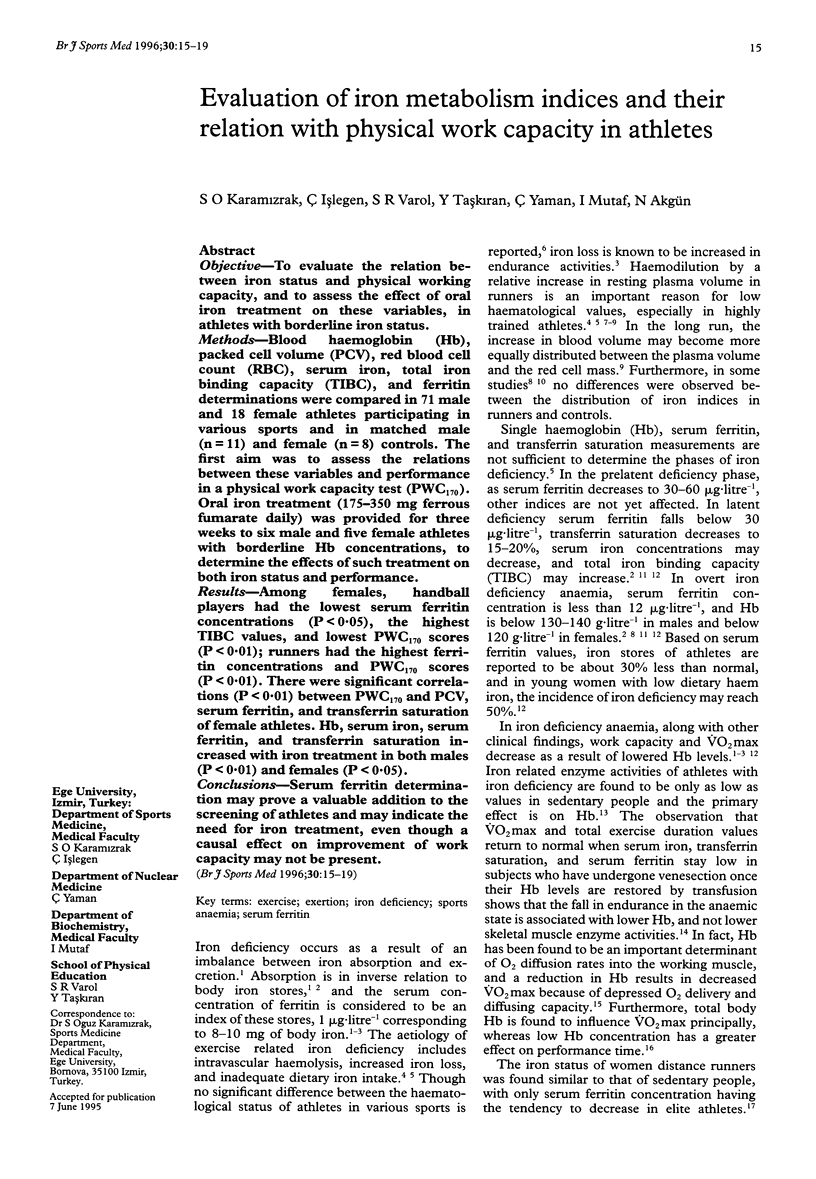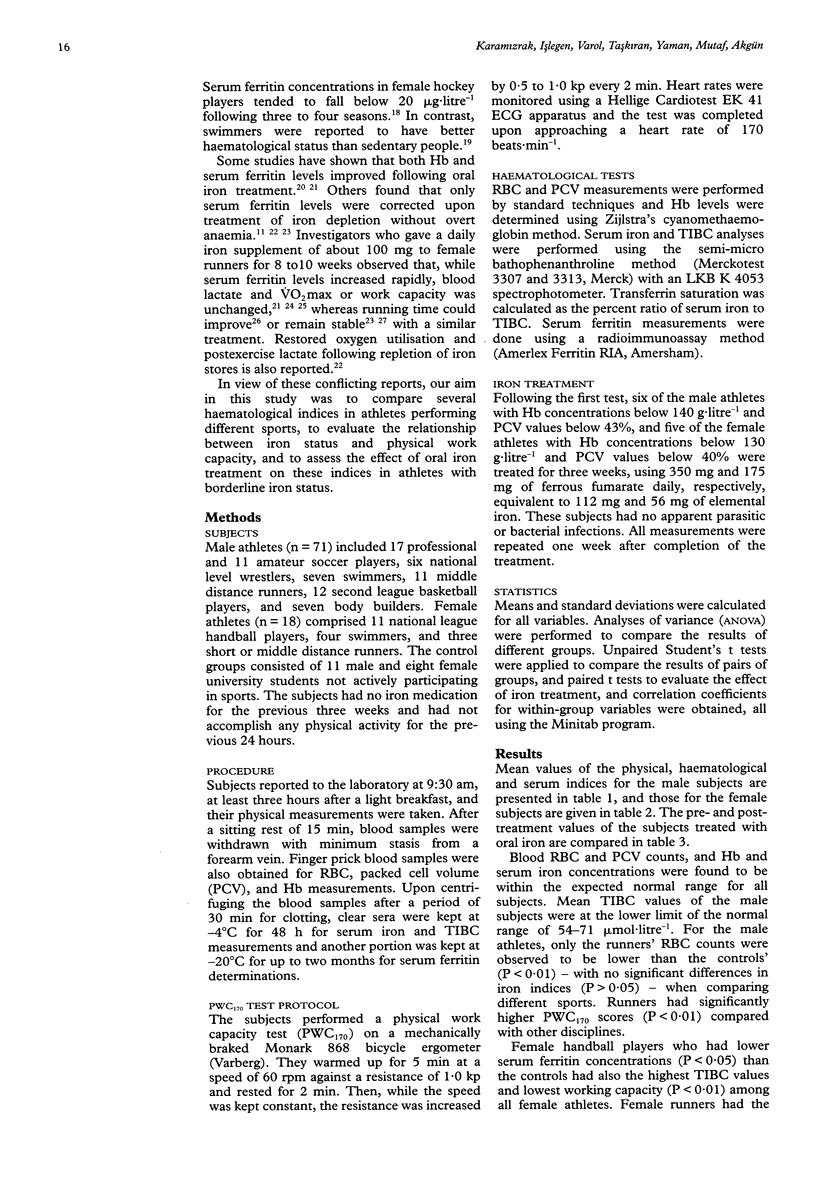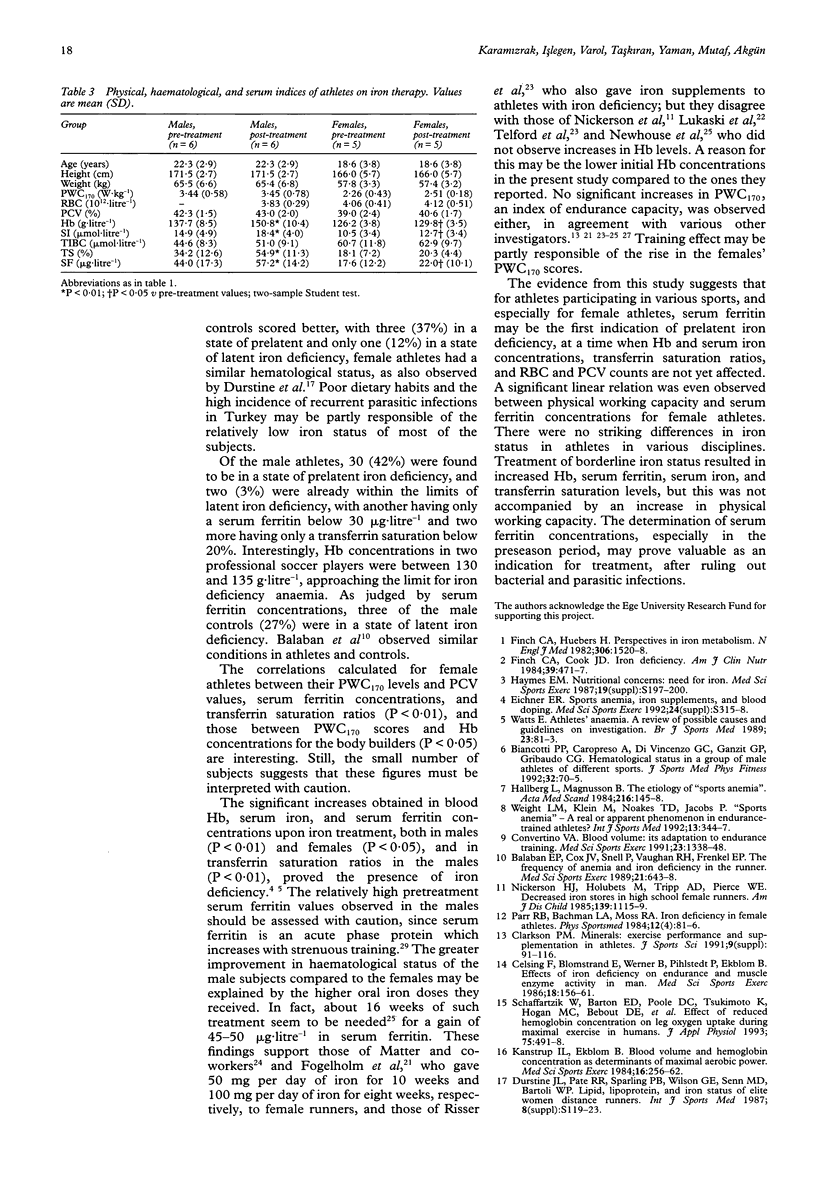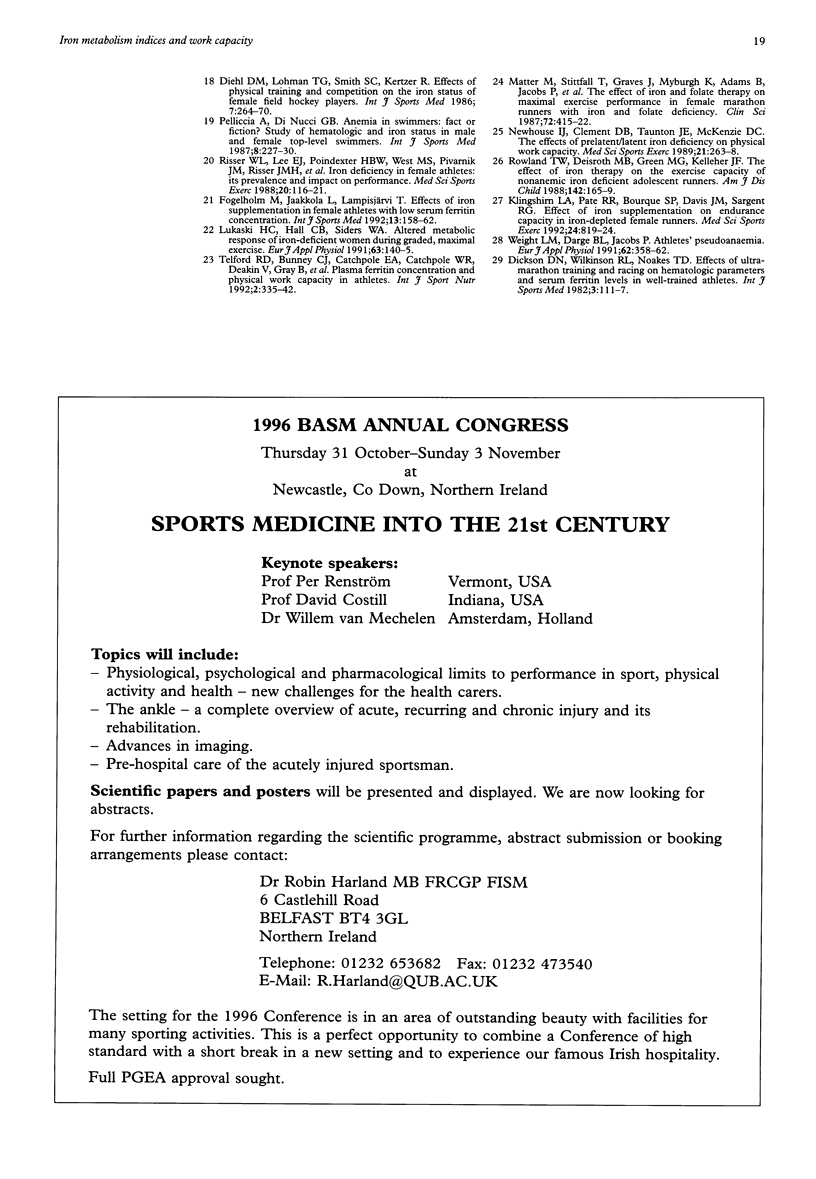Abstract
OBJECTIVE--To evaluate the relation between iron status and physical working capacity, and to assess the effect of oral iron treatment on these variables, in athletes with borderline iron status. METHODS--Blood haemoglobin (Hb), packed cell volume (PCV), red blood cell count (RBC), serum iron, total iron binding capacity (TIBC), and ferritin determinations were compared in 71 male and 18 female athletes participating in various sports and in matched male (n = 11) and female (n = 8) controls. The first aim was to assess the relations between these variables and performance in a physical work capacity test (PWC170). Oral iron treatment (175-350 mg ferrous fumarate daily) was provided for three weeks to six male and five female athletes with borderline Hb concentrations, to determine the effects of such treatment on both iron status and performance. RESULTS--Among females, handball players had the lowest serum ferritin concentrations (P < 0.05), the highest TIBC values, and lowest PWC170 scores (P < 0.01); runners had the highest ferritin concentrations and PWC170 scores (P < 0.01). There were significant correlations (P < 0.01) between PWC170 and PCV, serum ferritin, and transferrin saturation of female athletes. Hb, serum iron, serum ferritin, and transferrin saturation increased with iron treatment in both males (P < 0.01) and females (P < 0.05). CONCLUSIONS--Serum ferritin determination may prove a valuable addition to the screening of athletes and may indicate the need for iron treatment, even though a causal effect on improvement of work capacity may not be present.
Full text
PDF




Selected References
These references are in PubMed. This may not be the complete list of references from this article.
- Balaban E. P., Cox J. V., Snell P., Vaughan R. H., Frenkel E. P. The frequency of anemia and iron deficiency in the runner. Med Sci Sports Exerc. 1989 Dec;21(6):643–648. doi: 10.1249/00005768-198912000-00003. [DOI] [PubMed] [Google Scholar]
- Biancotti P. P., Caropreso A., Di Vincenzo G. C., Ganzit G. P., Gribaudo C. G. Hematological status in a group of male athletes of different sports. J Sports Med Phys Fitness. 1992 Mar;32(1):70–75. [PubMed] [Google Scholar]
- Celsing F., Blomstrand E., Werner B., Pihlstedt P., Ekblom B. Effects of iron deficiency on endurance and muscle enzyme activity in man. Med Sci Sports Exerc. 1986 Apr;18(2):156–161. [PubMed] [Google Scholar]
- Clarkson P. M. Minerals: exercise performance and supplementation in athletes. J Sports Sci. 1991 Summer;9(Spec No):91–116. doi: 10.1080/02640419108729869. [DOI] [PubMed] [Google Scholar]
- Dickson D. N., Wilkinson R. L., Noakes T. D. Effects of ultra-marathon training and racing on hematologic parameters and serum ferritin levels in well-trained athletes. Int J Sports Med. 1982 May;3(2):111–117. doi: 10.1055/s-2008-1026073. [DOI] [PubMed] [Google Scholar]
- Diehl D. M., Lohman T. G., Smith S. C., Kertzer R. Effects of physical training and competition on the iron status of female field hockey players. Int J Sports Med. 1986 Oct;7(5):264–270. doi: 10.1055/s-2008-1025772. [DOI] [PubMed] [Google Scholar]
- Eichner E. R. Sports anemia, iron supplements, and blood doping. Med Sci Sports Exerc. 1992 Sep;24(9 Suppl):S315–S318. [PubMed] [Google Scholar]
- Finch C. A., Cook J. D. Iron deficiency. Am J Clin Nutr. 1984 Mar;39(3):471–477. doi: 10.1093/ajcn/39.3.471. [DOI] [PubMed] [Google Scholar]
- Finch C. A., Huebers H. Perspectives in iron metabolism. N Engl J Med. 1982 Jun 24;306(25):1520–1528. doi: 10.1056/NEJM198206243062504. [DOI] [PubMed] [Google Scholar]
- Fogelholm M., Jaakkola L., Lampisjärvi T. Effects of iron supplementation in female athletes with low serum ferritin concentration. Int J Sports Med. 1992 Feb;13(2):158–162. doi: 10.1055/s-2007-1021248. [DOI] [PubMed] [Google Scholar]
- Haymes E. M. Nutritional concerns: need for iron. Med Sci Sports Exerc. 1987 Oct;19(5 Suppl):S197–S200. doi: 10.1249/00005768-198710001-00015. [DOI] [PubMed] [Google Scholar]
- Kanstrup I. L., Ekblom B. Blood volume and hemoglobin concentration as determinants of maximal aerobic power. Med Sci Sports Exerc. 1984 Jun;16(3):256–262. [PubMed] [Google Scholar]
- Klingshirn L. A., Pate R. R., Bourque S. P., Davis J. M., Sargent R. G. Effect of iron supplementation on endurance capacity in iron-depleted female runners. Med Sci Sports Exerc. 1992 Jul;24(7):819–824. [PubMed] [Google Scholar]
- Lukaski H. C., Hall C. B., Siders W. A. Altered metabolic response of iron-deficient women during graded, maximal exercise. Eur J Appl Physiol Occup Physiol. 1991;63(2):140–145. doi: 10.1007/BF00235184. [DOI] [PubMed] [Google Scholar]
- Matter M., Stittfall T., Graves J., Myburgh K., Adams B., Jacobs P., Noakes T. D. The effect of iron and folate therapy on maximal exercise performance in female marathon runners with iron and folate deficiency. Clin Sci (Lond) 1987 Apr;72(4):415–422. doi: 10.1042/cs0720415. [DOI] [PubMed] [Google Scholar]
- Newhouse I. J., Clement D. B., Taunton J. E., McKenzie D. C. The effects of prelatent/latent iron deficiency on physical work capacity. Med Sci Sports Exerc. 1989 Jun;21(3):263–268. [PubMed] [Google Scholar]
- Nickerson H. J., Holubets M., Tripp A. D., Pierce W. E. Decreased iron stores in high school female runners. Am J Dis Child. 1985 Nov;139(11):1115–1119. doi: 10.1001/archpedi.1985.02140130053029. [DOI] [PubMed] [Google Scholar]
- Pelliccia A., Di Nucci G. B. Anemia in swimmers: fact or fiction? Study of hematologic and iron status in male and female top-level swimmers. Int J Sports Med. 1987 Jun;8(3):227–230. doi: 10.1055/s-2008-1025660. [DOI] [PubMed] [Google Scholar]
- Risser W. L., Lee E. J., Poindexter H. B., West M. S., Pivarnik J. M., Risser J. M., Hickson J. F. Iron deficiency in female athletes: its prevalence and impact on performance. Med Sci Sports Exerc. 1988 Apr;20(2):116–121. doi: 10.1249/00005768-198820020-00003. [DOI] [PubMed] [Google Scholar]
- Rowland T. W., Deisroth M. B., Green G. M., Kelleher J. F. The effect of iron therapy on the exercise capacity of nonanemic iron-deficient adolescent runners. Am J Dis Child. 1988 Feb;142(2):165–169. doi: 10.1001/archpedi.1988.02150020067030. [DOI] [PubMed] [Google Scholar]
- Schaffartzik W., Barton E. D., Poole D. C., Tsukimoto K., Hogan M. C., Bebout D. E., Wagner P. D. Effect of reduced hemoglobin concentration on leg oxygen uptake during maximal exercise in humans. J Appl Physiol (1985) 1993 Aug;75(2):491–490. doi: 10.1152/jappl.1993.75.2.491. [DOI] [PubMed] [Google Scholar]
- Telford R. D., Bunney C. J., Catchpole E. A., Catchpole W. R., Deakin V., Gray B., Hahn A. G., Kerr D. A. Plasma ferritin concentration and physical work capacity in athletes. Int J Sport Nutr. 1992 Dec;2(4):335–342. doi: 10.1123/ijsn.2.4.335. [DOI] [PubMed] [Google Scholar]
- Watts E. Athletes' anaemia. A review of possible causes and guidelines on investigation. Br J Sports Med. 1989 Jun;23(2):81–83. doi: 10.1136/bjsm.23.2.81. [DOI] [PMC free article] [PubMed] [Google Scholar]
- Weight L. M., Klein M., Noakes T. D., Jacobs P. 'Sports anemia'--a real or apparent phenomenon in endurance-trained athletes? Int J Sports Med. 1992 May;13(4):344–347. doi: 10.1055/s-2007-1021278. [DOI] [PubMed] [Google Scholar]


